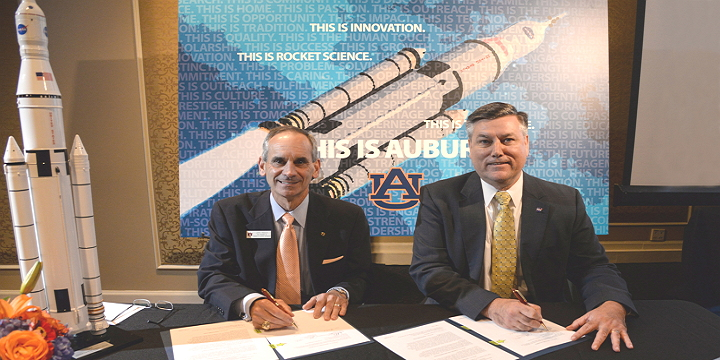
Space Act Agreements are legal compacts specified in the National Aeronautics and Space Act of 1958, and they’re used to empower NASA to work with any entity to enable the fulfillment of the NASA mandate.
John Mason, the Auburn University vice president for research and economic development, says additive manufacturing is a major advancement for US industries, and he added that the partnership with NASA will provide the university an opportunity to combine capabilities and expertise.
“We are establishing partnerships with highly innovative businesses and organizations to spur economic growth throughout the state and region,” Mason said. “These relationships benefit our students with learning experiences, while companies benefit from the practical, applied solutions developed through research conducted by faculty and students.”
Auburn University’s John Mason (left) and Patrick Scheuermann, director of NASA’s Marshall Space Flight Center in Huntsville (right), sign a Space Act Agreement [Photo: Auburn University]
According to Patrick Scheuermann, the director of NASA’s Marshall Space Flight Center in Huntsville, Alabama, the agreement will provide a critical academic connection to a variety of programs.
“As we continue developing the agency’s powerful new rocket, the Space Launch System, for deep-space missions to an asteroid and a journey to Mars, additive manufacturing techniques are making it possible to create and test innovative new designs quickly and affordably. Marshall is also pioneering the use of 3D printers in space, and the recycling and sustainability of advanced manufacturing materials needed to enable long-term missions,” Scheuermann says. “We’re pleased to partner with industry and academia as we focus on technologies that not only are central to the nation’s space mission but also benefit aerospace and other activities on Earth.”
For some 50 years the Marshall Space Flight Center has been the site of work on engines, vehicles, space systems, instruments and science payloads for missions of science and discovery in space, and it was at Marshall where the Saturn V rocket which carried astronauts on the Apollo missions was developed and built. Marshall has also developed rocket engines and tanks for the space shuttles, built sections of the International Space Station and manages science work of the astronauts aboard the International Space Station.
Greg Morris, the general manager of additive technologies with GE Aviation in Cincinnati, provided a keynote address for the recent “Additive Manufacturing, the Next Industrial Revolution” forum at Auburn. The forum featured leaders from the private sector, academia and government. As part of a $50 million project announced in 2014, GE Aviation is set to move high-volume additive manufacturing production to the company’s facility in Auburn. That facility will be used to additively manufacture jet engine fuel nozzles.
What do you think about NASA’s commitment to additive manufacturing and 3D printing? Let us know in the Auburn University and NASA forum thread on 3DPB.com.
